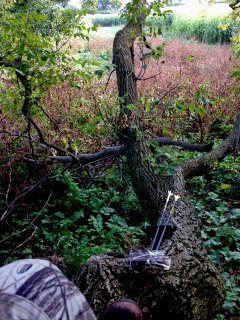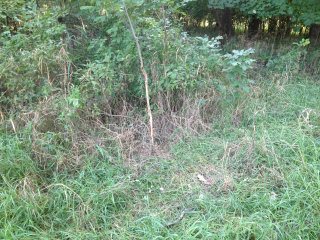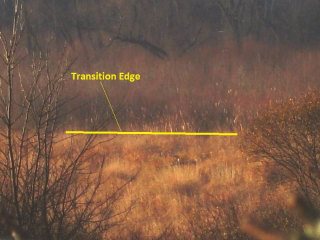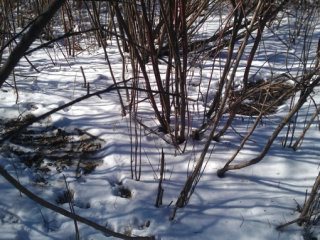The Element of Surprise – Keep Them Guessing
Category: article
Oct 15th, 2013 by OutdoorsFIRST
Modified Oct 15th, 2013 at 12:00 AM
It is without a doubt that snipers are the most effective weapons of war on the battle field and for good reason. Their unpredictable concealment and the element of surprise is what builds their lethal success. If not completely unaware, their targets are left guessing when and where the next strike may come from. Relating warfare to hunting whitetails is a bit of a stretch, but the concept of keeping your target guessing is exactly what many of today’s most consistently successful hunters will tell you puts them one step ahead of their next big buck.
 |
|
|
|
A mature buck only reaches the age of maturity for one reason – wisdom. With each year passed, many lessons learned. When faced with a “fight-or-flight” ultimatum, their answer to flee was decided at birth for whitetail deer. They use their innately profound sense of smell and hearing to alert them of the presence of danger, and their adaptability to nearly any environment makes relocating a walk in the park if you overstep their boundaries one too many times.
Over-sitting a particular stand leaves scent behind that can last for days from your last visit, and the same can be said for your walk-in route. If you are hunting between known bedding and feeding areas, deer won’t necessarily stop eating at the food source, but they will find alternate routes to get to and from.
PURPOSE IN THE WOODS
A common argument I’ve heard when discussing over-sitting a particular set is, “I hunt the same stand every time out and never have a problem seeing deer”. This often leads into questions regarding the distance at which they’re seeing the deer. If the answer is, “Close AND in range!”, I’m skeptical but will still give the benefit of the doubt – I have no reason not to, it doesn’t affect me. I do, however, walk away from those conversations wondering if the deer that are consistently showing up time and time again under the same stand after consecutive sits are mature deer. Now that is the question – are we talking BIG bucks, or are we talking deer in general?
For some, the name of the game has nothing to do with shooting a mature buck or doe and is more for the sake of meat. Most meat hunters will tell you, the younger the deer the better the meat. To that I agree, younger deer do make for tender table fare and certainly a younger deer is more susceptible to making mistakes than a mature deer, however, even the young ones have learned that foreign smells should be avoided.
ADAPT TO THE SEASONS
September is a time when an active bowhunter can pattern a big buck by its feeding habits as deer are literally slaves to their stomachs and haven’t felt hunting pressure since the previous year so their still on their summer time routes and schedule. If you swing and miss the first time in, your odds are greater if you’re prepared with a Plan “B”. Just as easy as you may think it is to pattern a deer early in the season, it’s even easier for a deer to pattern you after you’ve sat your stand once or twice.
Hunting pressure is largely accountable for why October is historically a quieter month in the deer woods. Older and wiser bucks know better than to leave their bedroom before the cover of darkness. An aggressive hunter who gambles on getting in close to a known big bucks bed and staging area stand a much greater chance of seeing him in range and killing him, but there’s risk involved and often times means a one-and- done sit in a particular tree. Still, if you don’t make a move now you may not see that deer until the rut when the allure of procreating steals his inhibitions, so do you gamble now or cross your fingers he sticks around during the chase phase of the rut?
 |
|
|
|
Come November, rut tactics don’t always apply to the all-season big buck hunter’s ninja-like approach during the early and late seasons. For some, hunting the rut is the only time of the year they’ll hit the woods with a bow in there hand and for appealing reasons. For starters, cooler temperatures are comfortable in the majority of hunting attire. Secondly, the bucks are on their feet, respondent to calling and seem to let their guard down when they’re on the trail of a hot doe.
I hunt the rut like a mad man, but I also have an addiction to the pursuit of killing a mature whitetail that is only fed by time spent in the woods. I begin at first legal shooting light every season and I quit at last light of the last day in the season. If there is one tactic I could suggest to the rut hunter who is willing to get mobile, so long as you’ve done your homework and know where the does are bedding or active scrapes are then find the closest transition edge downwind of them and set up. Lone bucks with love on their brain will scent check scrapes and common doe bedding areas by approaching downwind. Innately they will pick a transition edge to travel. Examples of transition edges would be terrain changes such as where cattails meet dogwood, where hardwoods meet a tall grassy meadow, or even elevation changes in the terrain.
 |
|
|
|
Ever sat a stand in the evening and heard a deer loudly raking on trees and rustling in a thicket out of range in the last hour of shooting light? How big he is, well, that’s left up to the imagination in moments like those. It’s a feeling of helplessness and curiosity. When combined with the insatiable focus on shooting a mature buck when you’re stuck in the stand under such circumstances, there’s little option other than to accept defeat or game plan for a new attack the next time out and take him by surprise where he’s least expecting it.
PREPARE YOURSELF AHEAD OF TIME
Scout, scout and scout some more. Learn the land you’re hunting so well, there’s little left to your imagination. A good time to do on-foot scouting is during the post season in late winter or early spring, especially if there is snow on the ground. Aerial imagery is available in many ways online. Contour maps are a great tool for determining the elevation lay of your land, even on flat land – a five foot elevation change could be huge in finding bedding areas. When you find beds, get right down into them and soak in the views from each of them – learning what deer can see from their beds may alter how high you hang your stands.
 |
|
|
|
KEEP AN OPEN MIND
I hunt stands that have been up in the same tree for years now, and those stands continue to produce opportunities year in and year out, however, those stands also don’t get sat every time out. I have many stands pre-hung for different winds in areas that are situated in spots that just don’t change from good to bad from one year to another, that is unless I were to over hunt them. Still the same, I also have climbing sticks and a light stand I can throw on my back and easily get situated in a tree quickly and most importantly, quietly. I may choose to remove the stand after my hunt, or, if I don’t plan to hunt the spot again because I consider it burned, I may return another day to recover it or after a morning hunt. I also hunt from the ground or other creative spots, like standing on the crotch of a gnarly tree I climbed up or crouched down in a thicket of tall grass or underbrush with just enough room to draw back before getting up on my knees to deliver some air mail.
A mature buck will only tolerate so much, which is why scouting more hours than you put into actually hunting is so effective. Consider mobility as a weapon when you’re actively pursuing big mature whitetails. That element of surprise is lethal, so keep them guessing.